Winter is when I do most of my fruit tree pruning. Why? Which kinds? Why most and not all? Let’s dive in.
See branches in winter
Fruit trees that lose their leaves in winter – deciduous fruit trees – offer a view of their branch structures at that time. When they’re covered in leaves in the summer it is not only hard to see their branches but more difficult to get your arms and tools inside the canopy to do any pruning. Therefore, it is easiest to prune deciduous fruit trees in winter, and so that’s when I prune most of them.
(Deciduous fruit trees that we grow in Southern California include apricots, pears, pomegranates, apples, plums, cherries, peaches, nectarines, pluots, figs, grapes, persimmons . . .)
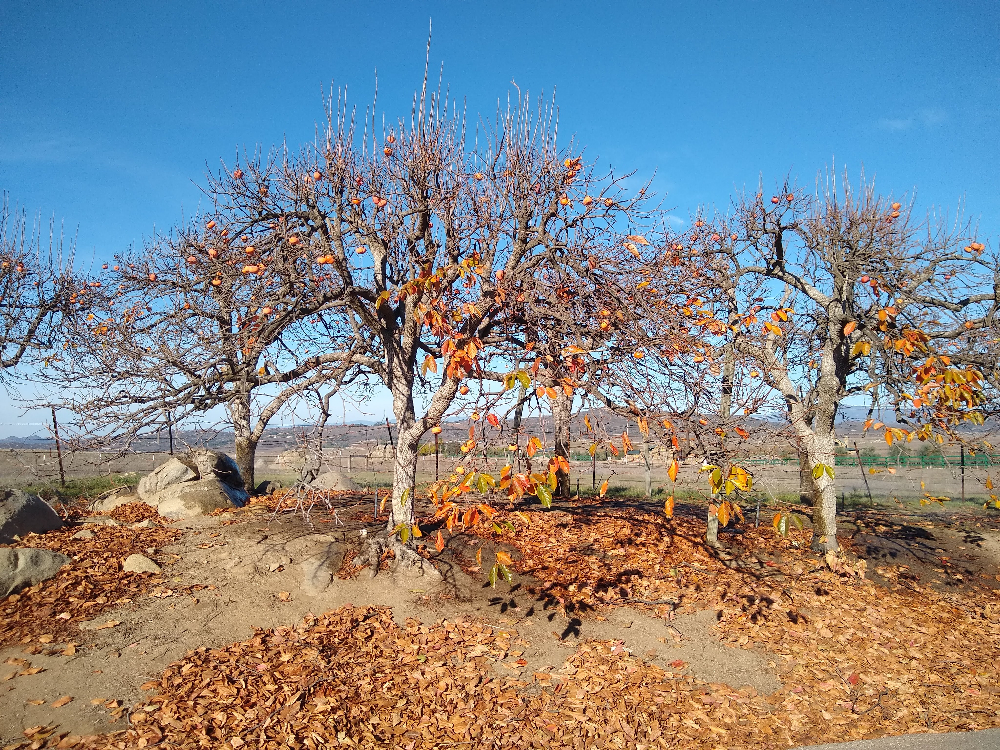
But it’s not necessary to wait until a tree has lost all of its leaves in order to start pruning. There is no harm or benefit from the tree’s point of view if you cut a branch while it still has some leaves.
Apple trees are usually the last deciduous fruit trees to drop their leaves. If your apple tree still has leaves while you are pruning your nectarine, and you feel like finishing your pruning that day, go for it. I often prune some trees before total leaf loss just because I’m out there with my tools.
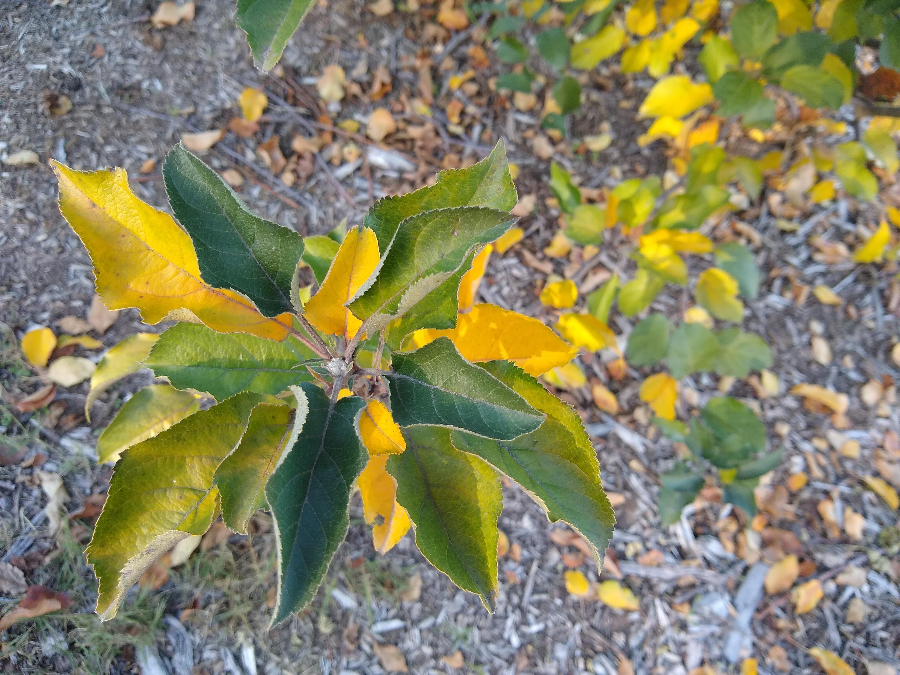
Avoid sunburn
Then we have the fruit trees that never go leafless (unless they’re dying!): the evergreens. Winter never gives us a better look at their branch structure, yet this season is still the best time to do significant pruning on them.
Use your imagination to understand why: Imagine you are bark on a citrus branch, and you’ve lived your whole life being shaded by branches and leaves above you. That’s what you’re used to. Then a gardener cuts off the branches and leaves above you, thereby exposing you to full sun – in the middle of summer. Ouch! You aren’t able to handle such intense sunlight, especially so abruptly, so you burn.
Now imagine that a smarter, kinder gardener cuts off the branches and leaves above you in the middle of winter. No problem. The sun is so weak in winter that it doesn’t burn you.
Moreover, on most citrus trees, just as on most other evergreen fruit trees, new branches and leaves start growing around the end of winter so a branch that was newly exposed to sun from a winter pruning will have new leaves to protect it with shade by the time the sun is strong in spring and summer.
Be a kind gardener to your evergreen fruit trees. If you want to do any serious size reduction on an avocado, guava, macadamia, mango, or citrus, do that pruning only in the winter.
In other words, don’t do this:
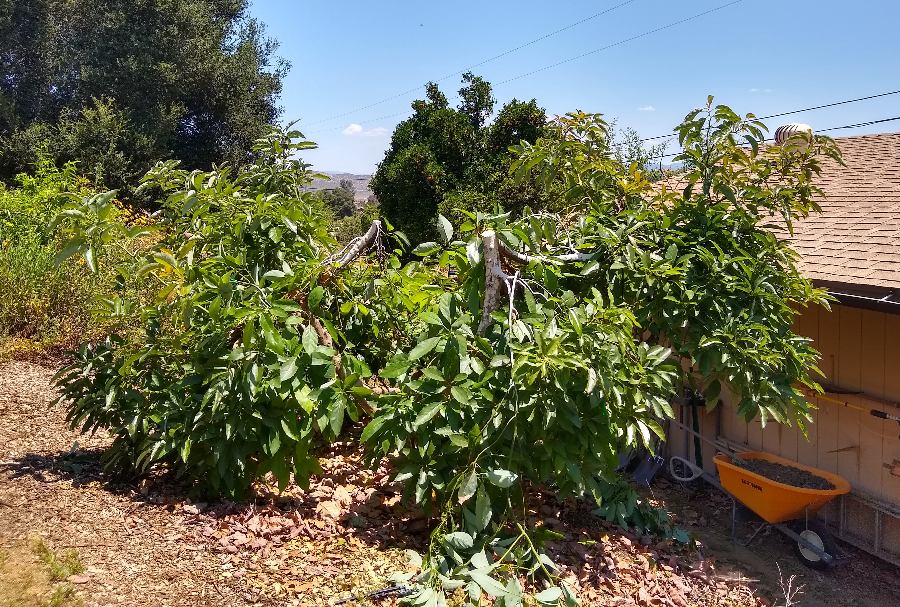
Rather, do this:

Know your cold threat
Also, do severe pruning on an evergreen fruit tree in the early or late winter according to how sensitive the tree is to cold damage and how likely your yard is to get cold enough to cause damage.
It is rare that citrus trees get damaged by cold in most of Southern California, but fruit trees like mangos and avocados are more sensitive. Mangos and avocados should only be pruned at the end of winter, once the threat of temperatures cold enough to do damage to them has ended, unless you know that your yard rarely gets a frost.
My yard in the foothills of San Diego County often gets cold enough to damage macadamias and avocados so I wait until March if I want to do any heavy pruning on them.
Glad I waited in 2020:
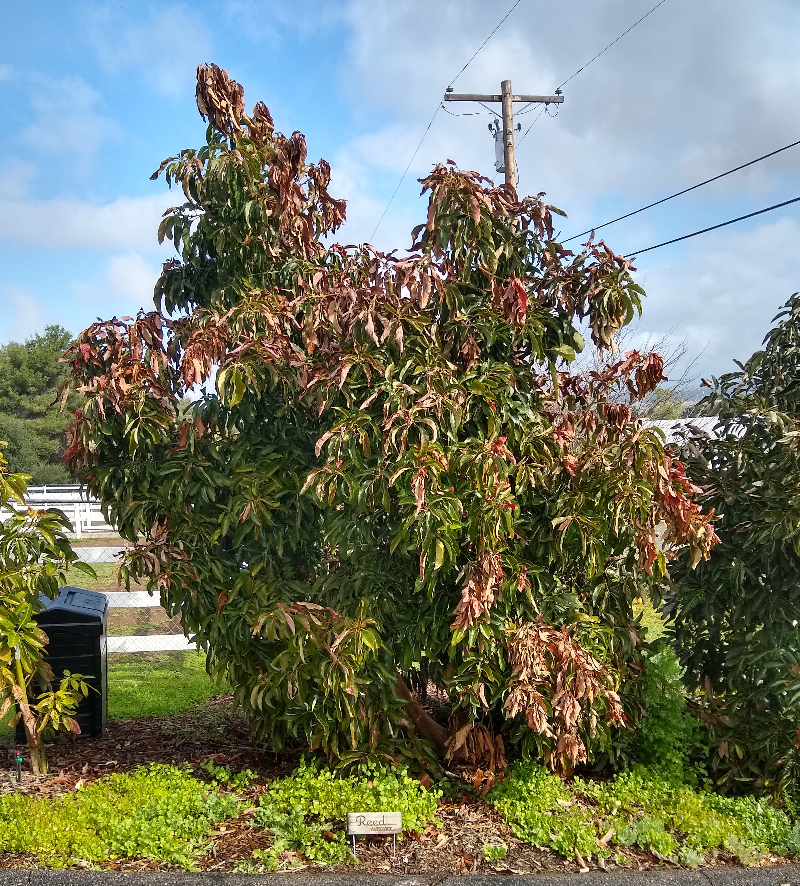
What kinds of pruning to do in other seasons?
On my deciduous fruit trees, I usually give them a buzz on the top at least once during summer so that the lower branches get enough sunlight. (See my post, “My best advice on pruning deciduous fruit trees: Keep them small.”)
On my evergreens, I cut small branches (up to about finger thickness) any time of year because this usually doesn’t expose them to sunburn.
Those are the only kinds of pruning I do outside of winter.
Why NOT prune fruit trees in winter?
Do not prune apricots and cherries and grapes in winter, it is advised in many University of California publications. (See here and here.) Why not? What will happen?
Various diseases are said to likely infect your trees. I’m uncertain about the need to follow this advice in Southern California, however. (In fact, I’ve never followed it.) I explore this in a post here.
And please find more posts on pruning here.
A list of all Yard Posts.
Do my posts help? Say thanks with a show of support.

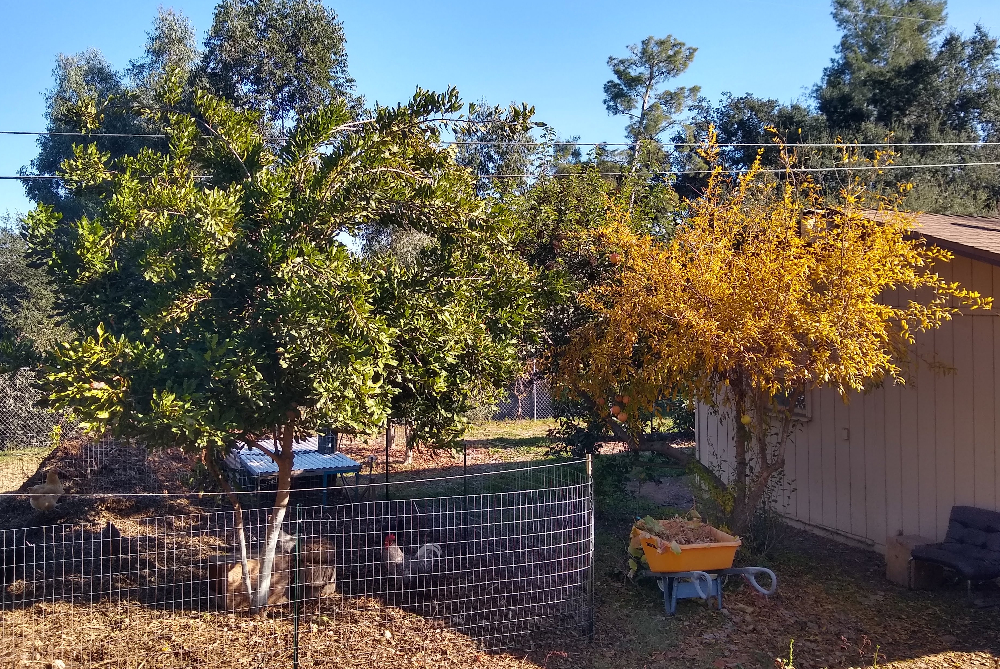


hello again: I have fruit on my hass and gem avocado trees. why would I prune these trees in winter?
tom
Hi Tom,
Are you referring to the sacrifice of the fruit if you prune in winter? This is a challenge, but it is even more difficult for late varieties such as Reed, Nabal, Lamb, and Hellen.
First, you only prune a tree if you have to in order to achieve some end, such as a height limitation. If you want your Hass tree to stay around 15 feet tall, then you have to prune it down to that height once it grows taller.
The best way I know how to do this while sacrificing the fewest fruit is by doing it as late as possible in winter or early spring. So, with Hass for example, you can cut back the top of the tree at the very end of winter or early spring and still eat whatever fruit comes down because Hass already tastes acceptable in March or April. You can use almost the same timing with GEM.
The fruit of the later varieties, however, aren’t mature at the end of winter. With them, you either have to prune in winter and sacrifice fruit or prune once the fruit is harvestable and accept some sunburn. I choose the former since I’m in a location with intense sun, but closer to the ocean trees don’t get sunburned as badly.
Hello! Great article, as usual! Are you planning on selling a 2024 calendar?
Hi Holly,
I am, but I am late. It should be ready in January.
Thanks — that’s great news! I’m a big fan of your calendars.
Hello Greg,
Thank you for the post! I thought I was ready to prune my 8 ft young avocado tree (that I purchased and planted just last July when it was only 2-3 ft tall). I want to maintain a lower height, but now will wait until closer to Feb/March before pruning.
It would be great if you could post or video on the aspects of pruning 🙂 I always learn something new from your posts.
Also, a separate question – have you ever dealt with grubs in your vegetable garden from june bugs or figeater beetles? My garden beds are infested. I’ve sprayed two rounds of beneficial nematodes last month but am still pulling out tons of very alive grubs. Just curious if you’ve had any experience to share.
Thank you as always!
Wai…beneficial nematodes will take some time to work. I do this every 2 years and usually see the benefit the next season. They spread very slow and does not have immediate effect.
Can’t believe I missed these responses – Thank you Jacques! Good to know on spraying every couple of years. I probably over did it, but am finally starting to find some dead grubs here and there. I think I’m more fearful that come spring, I’ll find thousands of figeater beetles emerging from my beds like the undead. Grateful for your reply 🙂
Hi Wai,
Any specific aspects of pruning that you’re curious about?
I have had lots of grubs in my vegetable garden dirt before, yes. I don’t do anything about them, except when I unearth one I take it to my chickens. It’s annoying when the skunks or raccoons or possums dig around to find them (and inevitably mess up your vegetables along the way), but otherwise I haven’t noticed the grubs themselves doing damage.
Hi Greg!
NM regarding pruning, I found an older video you made about 3 years ago on training young avocado trees and it was very helpful! I’m noticing my tree’s side branches are longer where they reach more sun – the shadier side has shorter branches so I think I will balance it out so that it does not become too heavy on the longer-branched side, as well as topping it down to 5-6 ft. It was helpful to see the different shapes and growth patterns of the ones you showed in the video 🙂
Regarding my nemesis grubs, this makes me feel better that you haven’t noticed much damage. I will say that my soil has become more light and airy and am sure they’re full of castings. I also now have a ton of earthworms and red wigglers that were never there before (I’ve only started gardening about a year ago.) But no joke I would find a minimum 50 grubs in just a square foot area of my 8×4 ft garden bed that are each about 15 inches deep – I have 5 beds and they burrowed deep down. My neck and back hates me. But good to know that you can just live with them.
Funny you mentioned skunks because I just discovered one had dug up some grubs the other night around my newly planted onion and snap pea seedlings. I caught it on our camera, we’ve seen the skunk before but never by my garden! I was so upset but also thankful at the same time? Glad it’s only come around that one night so far. Now I just leave a tray of fresh grubs I find and leave the tray on the ground in hopes it will come back!
Hello, I have a 6 year old Kalamata olive tree. I think it needs to be pruned or shaped. Is winter best for my tree?
Hi Greg,
After very low levels of fruitset on avocado trees growing near the coast in August 2023, the avocado trees are now blooming in December. What are your thoughts about this?
Thanks!
Hi Olivia,
I have been talking about this with many avocado growers up and down the state lately. It seems that everyone is getting bloom earlier than normal on some trees (not on all trees). At my place, I’ve got early bloom on Pinkerton and a couple of other varieties, but most of my trees don’t look near bloom. Elsewhere, I’ve seen Fuerte and Carmen already in bloom, and I’ve been told by others that their Sir-Prize are in bloom.
Some of these varieties commonly bloom early. Flowers in December on Fuerte, Carmen, and Pinkerton are not surprising. I had never heard of such early bloom on Sir-Prize though.
What seems unusual is how wide spread and intense the early bloom is. My Pinkerton tree, for example, has had a few pops of bloom early before, but today the entire tree is flushing out in full bloom.
Why is this happening? I don’t know. Maybe it’s related to last year’s great rains but poor fruitset, which has put trees in a status where they have energy to burn. They’re so full of energy that they can’t wait to push out the flowers. Since it has also been a mild to warm fall (not a cold fall, that’s for sure), then they are encouraged to grow in this way. These are just guesses.
I don’t like the early bloom on my trees. Temperatures are not good for pollination now. The nights are too cold. I’m afraid the flowers will be wasted and not many will be left in spring when pollination weather is better. We’ll see.
Thank you, Greg, for your detailed and informative response!
Appreciatively,
Olivia
Yup, my Pinkerton is in a full bloom and set no (zero) fruit last year. My fuerte has some blooms but not in a full bloom at all. It’s definitely been a warm fall. A holdover zucchini plant in the garden put out blooms and set a few but they’re growing very slowly and very small.
I’m so pleased to have found your post.
We have a lovely Yellow Guava tree in our front yard. Last winter we trimmed back a low main branch. It seemed to be okay this whole year until now. It has grown a huge number of new branches so heavy with fruit it’s bending the bigger branch and “trunk” downward. I’m afraid it’s going to uproot or break off. Do we just saw it back now? Or do we try to prop it up and cut it back in January or February??
Hi Jul,
I think you could go either way, but the safest is to cut it back because props sometimes fail.